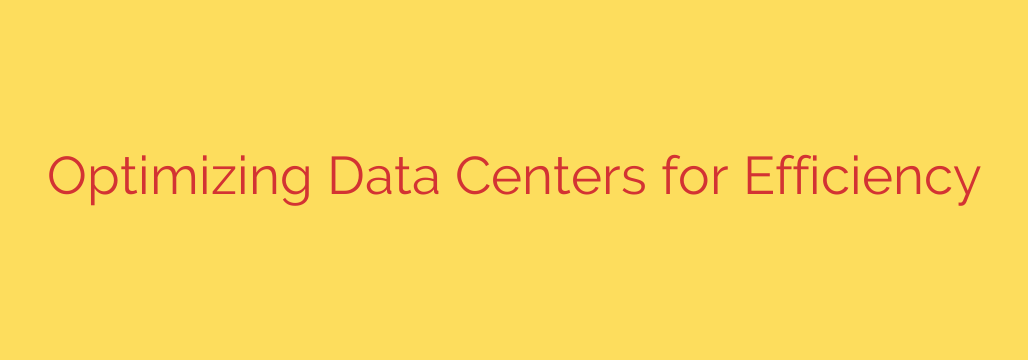
How to Optimize Your Data Center for Maximum Efficiency and Performance
Data centers are the digital heart of the modern world, powering everything from cloud computing and streaming services to global finance. But this incredible processing power comes at a cost—a massive consumption of energy. As operational expenses rise and environmental concerns grow, optimizing your data center for efficiency is no longer a luxury; it’s a strategic necessity.
An inefficient data center wastes money, strains power grids, and has a significant carbon footprint. The key to tackling this is a holistic approach that addresses cooling, IT hardware, power management, and intelligent software. By implementing smart strategies, you can drastically reduce costs, improve performance, and build a more sustainable operation.
Rethinking Your Cooling Strategy
One of the biggest energy drains in any data center is cooling. In fact, it can account for up to 40% of total electricity usage. Traditional methods often cool entire rooms, which is incredibly wasteful. Modern approaches focus on targeted, intelligent cooling.
Key strategies include:
- Hot Aisle/Cold Aisle Containment: This is a fundamental and highly effective technique. By organizing server racks into rows with alternating cold air intakes (cold aisles) and hot air exhausts (hot aisles), you prevent hot and cold air from mixing. Containing these aisles with barriers (like vinyl curtains or hard panels) ensures that chilled air is delivered exactly where it’s needed and hot exhaust air is efficiently removed. This simple change can lead to energy savings of 20-40%.
- Liquid Cooling: As server density and power consumption increase, air cooling reaches its limits. Liquid cooling is a far more efficient alternative. Direct-to-chip cooling brings liquid-filled cold plates into direct contact with high-heat components like CPUs and GPUs, removing heat far more effectively than air. More advanced immersion cooling involves submerging entire servers in a non-conductive dielectric fluid, offering the ultimate in thermal efficiency.
- Increase Operating Temperatures: Many data centers are over-cooled. Modern IT equipment is designed to operate safely at higher temperatures than older hardware. By gradually raising the ambient temperature of your facility in line with manufacturer specifications (ASHRAE guidelines), you can significantly reduce the load on your cooling systems.
Modernize Your IT Hardware and Embrace Virtualization
Outdated, underutilized servers are silent energy vampires. A single server running at just 10-15% capacity can still draw a significant amount of power. The solution lies in consolidating your hardware and leveraging modern technology.
- Server Virtualization: This is the practice of running multiple independent “virtual” machines on a single physical server. Virtualization dramatically increases server utilization, allowing you to consolidate workloads from dozens of old servers onto a handful of new, efficient ones. This reduces your physical footprint, power consumption, and cooling requirements all at once.
- Hardware Refresh Cycles: Regularly upgrading to the latest generation of servers, storage, and networking equipment is crucial. Newer hardware is not only more powerful but also engineered for energy efficiency. For example, swapping old spinning hard disk drives (HDDs) for solid-state drives (SSDs) not only boosts performance but also lowers power usage and heat output.
Master Your Power Infrastructure
Efficiency starts with understanding where your power is going. The industry-standard metric for this is Power Usage Effectiveness (PUE), which is the ratio of total facility energy to the energy delivered to IT equipment. A perfect PUE is 1.0, though a score below 1.5 is considered highly efficient.
Actionable steps to improve your PUE include:
- Invest in High-Efficiency UPS Systems: Your Uninterruptible Power Supply (UPS) is critical for reliability, but older models can be shockingly inefficient, especially at low loads. Modern, modular UPS systems operate at over 95% efficiency across a wide range of load levels, minimizing wasted energy.
- Use Intelligent PDUs: Smart Power Distribution Units (PDUs) allow you to monitor power consumption at the individual outlet level. This granular data is invaluable for identifying “ghost servers” (servers that are powered on but doing no useful work) and understanding the power draw of specific applications.
Leverage Software and Automation for Smart Management
You can’t optimize what you can’t measure. Modern data centers rely on sophisticated software to provide real-time visibility and automated control over the entire facility.
- Data Center Infrastructure Management (DCIM): DCIM software is the central nervous system of an efficient data center. It integrates data from your power systems, cooling units, environmental sensors, and IT hardware into a single dashboard. This allows you to monitor PUE in real-time, track environmental conditions, and model the impact of changes before you implement them.
- AI and Machine Learning: The next frontier in optimization is using artificial intelligence (AI) to predict and prevent issues. AI algorithms can analyze historical data to predict cooling needs, dynamically allocate workloads to the most efficient servers, and even anticipate hardware failures before they occur, leading to unprecedented levels of efficiency and uptime.
By focusing on these core areas, you can transform your data center from a costly energy consumer into a lean, high-performing asset. The journey to optimization is continuous, but the rewards—in cost savings, reliability, and sustainability—are well worth the effort.
Source: https://datacenternews.asia/story/how-optimisation-is-helping-to-tackle-the-data-centre-efficiency-challenge








